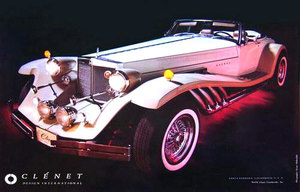
To Alfred DiMora, designing, building and selling a $2 million limited-production super-exotic sedan seemed like a good enough idea in 2007.
The economy was flush and more than enough hedge fund captains and assorted other Masters of the Universe were spending money like water and buying-up (while speculating on and often ruining the market for us regular folks) private jets, classic cars, restored steam engines, fleets of ocean-going yachts with helicopters (and landing pads) and all other manner of expensive, one-of-a-kind "transportation."
And, he says, he already has 37 orders for the "Natalia SLS 2" (Natalia being his mother's maiden name). Far be it from him to disappoint these early-adopter customers.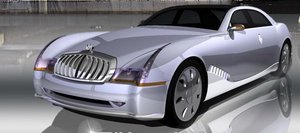
(Computer rendering of DiMora Motorcar's $2 million Natalia SLS 2).
He's the founder of DiMora Motorcar, based in Palm Springs, CA, and creator of Starbridge Systems, which developed what he says is the world's fastest FPGA supercomputer.
When we asked DiMora yesterday why, in light of the world economy, he hasn't stopped or at least delayed the venture, he told us, "Creating any car is a five-year project, and now that I'm 2 ½ years into this one, I'm determined to see it through."
Yes, he's done something similar before.
DiMora is well-known in the auto industry for designing mid-1970's high-end, high-concept "neoclassic" cars with a 1930's-style design theme, including the Clenet and Sceptre.
Some automotive purists consider both cars sacrilege, with a retro-styled body placed over a clunky, Detroit-built, rear-drive large car platform. DiMora says they sold almost 500 Clenets and Sceptres combined, which were highly-priced for their times (up to $65,000).
(Alfred DiMora).
What kind of people bought them? Many years ago, while driving through Hollywood, I saw Lyle Waggoner (from the old Carol Burnett TV show) in his two-seat, open-top Clenet, with vanity license plates reading "Mr. Cool."
That about said it all for me as far as the car (and Waggoner) were concerned; but just because I didn't much like the car's looks, or have much respect for the people that bought them, obviously, other people did.
With his electronics and automotive backgrounds, DiMora thinks he has the right blend of experience to create the Natalia, planned to be a hand-built-to-order super-exotic with a powerful V16 engine and the latest in technology.
(One of DiMora's 1970's design efforts, the neo-classic Clenet).
DiMora knows that even as the world economy continues to tank, there are segments of society which can ride out almost any financial storm and continue their profligate ways. At least he hopes so.
In the supercar production arena, the Bugatti Veyron is currently the priciest of the lot at about $1.6 million. Who buys these kinds of cars? A Veyron owner is Simon Cowell of American Idol fame. 
(American Idol's Simon Cowell exits his $1.6-million Bugatti Veyron, somewhere in Los Angeles).
And Palm Springs itself owns an important footnote in the history of American automotive design.
The original and still-futuristic Studebaker Avanti, which management prayed would save the company, made its advent in 1962 as a 1963 model.
The fiberglass-bodied Avanti was engineered and styled in 1961 during an intense five-week session led by famed industrial designer Raymond Loewy, whose streamlined locomotives, Greyhound busses and the Coke bottle, among many other products, quickly became American classics. Avanti was even named the Official (honorary) Pace Car of the 1962 Indianapolis 500; alas, it was for naught, as Studebaker died soon after the radical new car's advent (though Avanti lives on today in various iterations from the many companies which have held the rights to the car since).
Though almost every major car maker now has a design studio in Southern California, Palm Springs was the first So Cal city which gave America a look at some aspects of the automotive future. So DiMora believes in the good karma of the place for his project.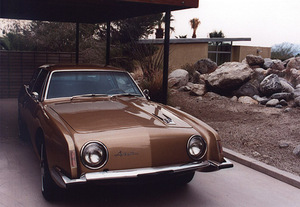
(An original Studebaker Avanti in the carport outside Raymond Loewy's 1946 Albert Frey-designed modernist house in Palm Springs, CA; and yes, this car was painted to match the house's typical desert-toned color).
DiMora is building what is essentially a virtual car company (and some say Natalia might well remain a virtual car); instead of large, experienced parts developers and suppliers going through the traditional process of building production facilities near a plant where Natalia would be assembled, DiMora says he is challenging private industry and universities across America to come up with all-new materials and parts for the car at their existing research and development labs.
"Because of the cost of each car," DiMora, 52, told us, "we really have no hard and fast budget to hold to when it comes to its parts. It's sort of 'anything goes.'"
The Rochester, NY, native says the following companies are among those involved in Natalia's parts process:
- A Palm Springs company, Champion Bearing, will supply high-tech silicon nitrate ball bearings for many of the car's critical parts;
- Brembo, the Italian brake-maker, is working on a system which can capture the heat from braking and transfer it into energy for Natalia's electronics, similar in some ways to the newly-mandated Kinetic Energy Recovery Systems (KERS) soon due in Formula 1 race cars;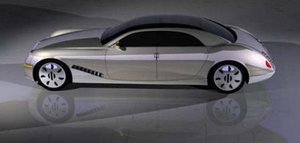
(Another computer-generated view of the Natalia SLS 2).
- Prometal is creating the all-aluminum 855-cubic inch V16 1,200-horsepower "Volcano" engine (I can already hear Jay Leno's jokes about that name);
- Epner Technologies will produce 24 carat gold leaf for the engine compartment both to provide a sharp appearance and possibly be used as heat-protection on a future 1,600-horsepower turbocharged Natalia;
- American Glass Products will supply their Vario-Plus product for the car's windows and its glass roof, which can be adjusted to allow in only as much light as Natalia's driver and passengers desire;
- Barotex will incorporate a new production method for the car's unibody chassis called D-tack, which makes use of volcanic rock, which DiMora claims is similar to carbon fiber in its weight and strength, and,
- Clemson University's CUI-CAR, their International Center of Automotive Research, is working to supply Natalia's light and strong titanium suspension bits.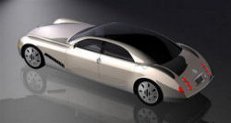
And, yes, he's already making plans for various alt fuel and hybrid versions of the car.
It's easy to doubt DiMora, but he's also a great PR man and marketer; he enthusiastically sells himself and his ideas, with the ability to quickly turn doubters into true believers.
The $2 million price tag is a gimmick, to be sure, as is the Volcano engine name, both used to get media attention - and it's worked; Natalia has been written-about in scores of newspapers and magazines and on websites worldwide. Google the DiMora or Natalia name and see what happens.
And the fact remains that DiMora has been involved in successfully building small runs of very expensive specialty cars before.
Will DiMora actually build his $2 million car? He says he hopes to deliver the first ones in 2011. And remember those 37 orders.
In the car world, stranger things have happened.
